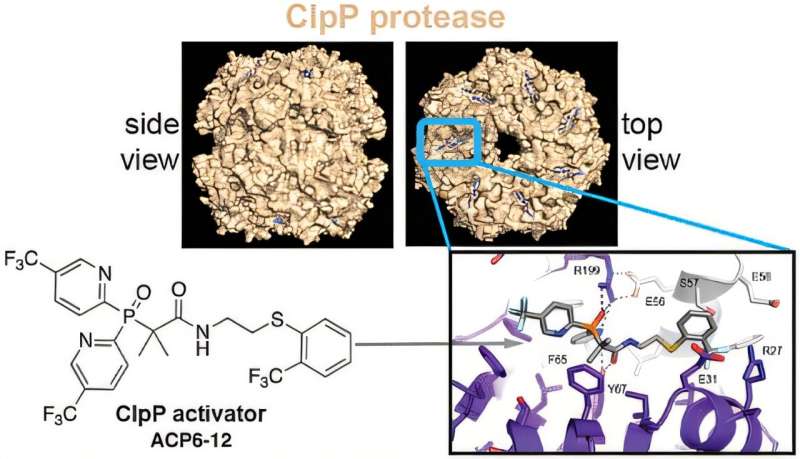To address the global threat of antibiotic resistance, scientists are on the hunt for new ways to sneak past a bacterial cell’s defense system. Taking what they learned from a previous study on cancer, researchers from the University of Toronto (U of T) have developed novel compounds that trigger bacterial cells to self-destruct.
The team’s results appear in the Journal of Medicinal Chemistry.
The new form of antibiotics is designed to target a naturally occurring enzyme—caseinolytic protease proteolytic subunit, ClpP, for short—which chews up old or defective proteins and plays an essential role in cellular housekeeping. The new compound kicks the ClpP enzyme into overdrive, so it begins chewing up proteins that it is not supposed to, eventually killing its own cell from the inside out.
“Most antibiotics inhibit a process,” says Dr. Walid A. Houry, professor of biochemistry at the University of Toronto. “With this approach, we are dysregulating a process, and this allows us to develop this new class of compounds that we eventually hope to get into a clinic.” Houry worked closely with Dr. Robert Batey and colleagues to build upon their previous work in this area.
“It turns out that the [enzyme] present in cancer cells is also present in bacteria. For this project, the tricky thing was trying to find a way to hit the bacterial ClpP, but not the human ClpP,” Houry adds.
The Canadian Light Source (CLS) at the University of Saskatchewan’s (USask) CMCF beamlines enabled Houry’s team to visualize the structural differences between human and bacterial ClpP, and understand how their new compounds behaved when attacking ClpP. The group capitalized on the minor structural differences between the human and bacterial enzymes to design compounds that could target harmful bacteria without damaging human cells along the way.
This new approach to antibiotics, says Houry, holds great potential for treating bacterial infections such as meningitis and gonorrhea.
More information:
Funing Lin et al, Structure-Based Design and Development of Phosphine Oxides as a Novel Chemotype for Antibiotics that Dysregulate Bacterial ClpP Proteases, Journal of Medicinal Chemistry (2024). DOI: 10.1021/acs.jmedchem.4c00773
Provided by
Canadian Light Source
Citation:
Team develops promising new form of antibiotic that makes bacterial cells self-destruct (2024, October 18)
retrieved 18 October 2024
from https://phys.org/news/2024-10-team-antibiotic-bacterial-cells-destruct.html
This document is subject to copyright. Apart from any fair dealing for the purpose of private study or research, no
part may be reproduced without the written permission. The content is provided for information purposes only.

